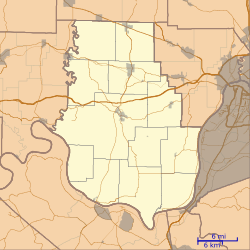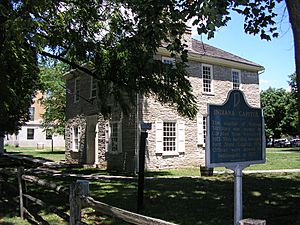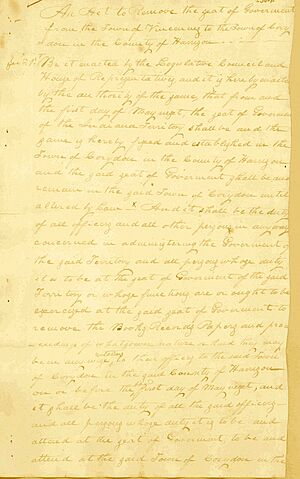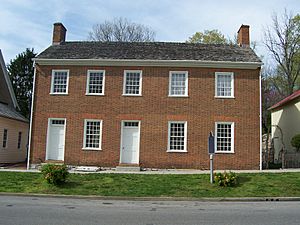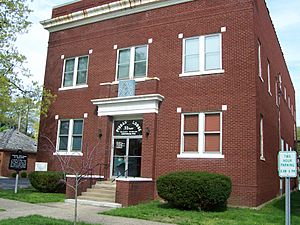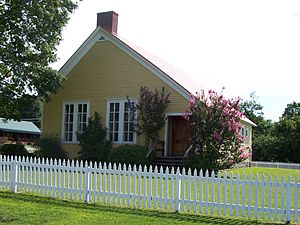Corydon Historic District facts for kids
Quick facts for kids |
|
|
Corydon Historic District
|
|

Old State Capitol
|
|
| Location | Not specified (original); Roughly bounded by Summit, Maple & Walnut Sts., College Ave., Chestnut, Capitol, Poplar, Water, Beaver & Mulberry Sts. (increase), Corydon, Indiana |
|---|---|
| Built | 1813 |
| Architect | George L. Mesker & Co.; William Mitchell (increase) |
| Architectural style | Federal (original); Italianate, Queen Anne (increase) |
| NRHP reference No. | 73000017 and 89000243 |
| Added to NRHP | August 28, 1973 (original) June 27, 1989 (increase) |
The Corydon Historic District is a special area in Corydon, Indiana, United States, filled with important old buildings. Corydon is famous for being Indiana's First State Capital. This historic district was first added to the National Register of Historic Places in 1973. Later, in 1988, it was made even bigger to include more historical places.
The district has many cool old buildings. Some of the most famous ones are the Old Capitol, which was Indiana's first state capitol building, and the Old Treasury Building. You can also find Governor Hendricks' Headquarters, the Constitution Elm Memorial, and the Posey House here. Other important places include the Kintner-McGrain House and The Kintner House Inn.
History of Corydon
Corydon, Indiana, was planned out in 1808. It is still the main town for Harrison County, Indiana. Corydon was the second capital of the Indiana Territory from 1813 to 1816. But it's most famous for being the very first capital of Indiana from 1816 to 1825. Many of the important buildings in the historic district are from this early time. The Old Capitol is the most important building in the district.
Becoming the Capital
Corydon became the capital of the Indiana Territory in 1813. This happened after the capital moved from Vincennes. Dennis Pennington, a leader from Harrison County, helped make Corydon the capital. He pointed out that the new Harrison County Courthouse could be used for the territorial government. Pennington was put in charge of building this courthouse, which later became known as the Old Capitol.
The Constitution Elm
In 1816, a special meeting was held in Corydon to decide if Indiana should become a state. Forty-three people met from June 10 to 29, 1816. They worked on Indiana's first state constitution. The courthouse was not finished yet, so they met in a small log home. Because it was crowded and hot, they often gathered outside under a huge elm tree. This tree was later called the Constitution Elm. Today, the historic district has a part of this tree's trunk, protected by a sandstone memorial.
Indiana's First State Capital
The Indiana General Assembly met for the first time in Corydon on November 4, 1816. Indiana officially became the nineteenth state in the United States on December 11, 1816. Corydon served as Indiana's first state capital until 1825. Then, the state government moved to Indianapolis.
When the historic district was first recognized in 1973, it included eight important places from 1816. These were the Old Capitol building, the public square around it, Indiana's first state office building, Governor William Hendricks' Headquarters, the Constitution Elm, the Posey House, the Westfall House, the Branham home/tavern, and the Kintner-McGrain House.
In 1989, the district was made larger to include more historic buildings. This included commercial and residential buildings built after 1825. It also added a new, three-story Harrison County Courthouse finished in 1929.
Later History and Memorials
A historical marker on the Harrison County Courthouse lawn tells about the Battle of Corydon. This battle happened on July 9, 1863, when Confederate soldiers led by John Hunt Morgan came to Corydon. The actual battle site is outside of town and is listed separately.
The courthouse square also has a memorial for former Indiana governor Frank O'Bannon. It includes a bronze statue of him sitting on a limestone bench. There are also three pillars honoring his father and grandfather. This memorial was dedicated in June 2008. Because of its rich history, Corydon welcomes about 30,000 visitors every year.
Notable Sites to Explore
Old Capitol Building
The Old Capitol building is a key part of the Corydon Capitol State Historic Site. It is managed by the Indiana State Museum. This two-story building is made of limestone and has a Federal-style design. It was Indiana's first state capitol from 1816 to 1825.
Construction started in 1814 when Corydon was the capital of the Indiana Territory. It was almost finished in 1816, the year Indiana became a state. The building was mainly used for the territorial and state legislatures. The county government also used it when the Indiana General Assembly was not meeting. Dennis Pennington, who helped build it, later became the first speaker of the Indiana Senate.
The building is about 40 feet (12 meters) square. Its walls are 2.5 feet (0.76 meters) thick. The outside stones are roughly cut. The lower floor has 15-foot (4.6 meters) ceilings and flagstone floors. The upper floor's ceiling is 10 feet (3 meters) tall. The original building had a symbol of justice on the roof, but it was replaced with a bell in 1833.
When Corydon became the state capital, the Indiana Supreme Court and the Indiana Senate met on the upper level. The Indiana House of Representatives met on the first floor. After 1825, when the capital moved to Indianapolis, the Old Capitol was used as the Harrison County Courthouse until 1929.
In 1917, the State of Indiana bought the Old Capitol to save it. It opened to the public in 1929 and is now a protected memorial. The building has been restored to look as much like its original self as possible. In 2015, a big project updated the town square around the Old Capitol.
First State Office Building
This building, also called the Old Treasury Building, was built in 1817. It held state government offices, including the first state auditor's and treasurer's offices. It is located on Walnut Street. The Indiana State Museum started a big renovation of this building in 2008.
Governor Hendricks's Headquarters
This building is also part of the Corydon Capitol State Historic Site. Davis Floyd, who was a state legislator, built this home in 1817. After he lost the home, the state bought it for Indiana's governor. It became a state historic site in 1979.
William Hendricks lived here from 1822 to 1825 when he was governor of Indiana. He was also Indiana's first representative to the U.S. House of Representatives. Later, William A. Porter, a lawyer and judge, bought the building in 1841.
Constitution Elm Memorial
The Constitution Elm remembers the first state constitutional convention. This meeting happened from June 10 to 29, 1816. Forty-three people met in Corydon to write Indiana's state constitution. Because their meeting place was small and hot, they often gathered outside under a large elm tree. This tree became known as the Constitution Elm.
It is believed the giant elm was about 50 feet (15 meters) tall. Its trunk was about 5 feet (1.5 meters) across, and its branches spread over 132 feet (40 meters). Sadly, a tree disease destroyed the tree in 1925. However, its trunk has been saved and is protected by a sandstone memorial.
Posey House
The Posey home was included in the historic district in 1973. Allan D. Thom and Thomas Lloyd Posey started building it in 1817. Colonel Posey was the son of Thomas Posey, who was governor of the Indiana Territory. Colonel Posey was active in Harrison County and even raised fourteen orphans in this home.
Most of the two-story brick home was built between 1817 and 1818. It had a main house, a wing for offices and a shop, and a two-story back part with a dining room and kitchen. The property also had woods and a spring. The Daughters of the American Revolution owned it for many years. In 2012, it was given to the Historical Society of Harrison County.
Westfall House
The Westfall House is a log cabin near the Constitution Elm. It is the oldest building still standing in Corydon. This home is privately owned and not open to the public.
Branham Home/Tavern
William Branham started a tavern here in 1809. The building itself was originally built in 1800.
Kintner-McGrain House
This house was first called Cedar Glade. It was the home of Jacob Kintner, who built this Greek Revival-style house in 1808.
Kintner House Hotel
The Kintner House Hotel was finished in 1873. It had twenty-six rooms for guests. In the early 1900s, it became apartments and other businesses. In 1986–87, it was renovated into a bed and breakfast inn.
Harrison County Courthouse
The three-story Harrison County Courthouse is next to the Old Capitol. It was completed in 1929.
Grand Masonic Lodge
The Grand Masonic Lodge in Indiana started in 1818. This is the oldest Masonic Lodge building in Indiana. Important people like State Senator Dennis Pennington and Indiana's first governor Jonathan Jennings were among its first members. The current lodge building on Elm Street was built in 1926. It is still used by Masons and the Order of the Eastern Star.
Leora Brown School
Construction on this school began in 1891. It was first known as the Corydon Colored School. It served as a school for the community's black students. The first high school students graduated in 1897. In 1949, Indiana passed a law to desegregate public schools. The Corydon Colored School closed in 1950 when Corydon schools became integrated. In 1987, the school was renamed for Leora Brown Farrow. She was the school's longest-serving teacher, teaching there from 1924 until 1950.
The school is now a cultural center, converted in 1993.
Gallery
See also


